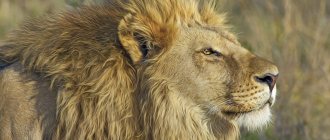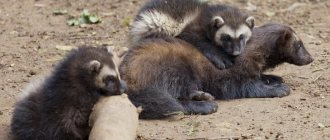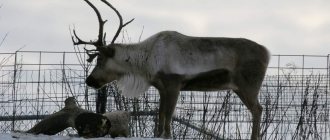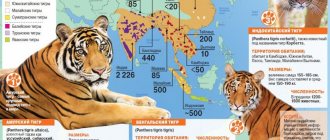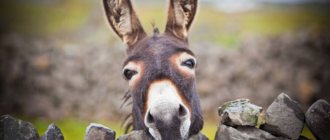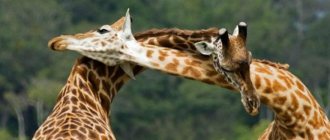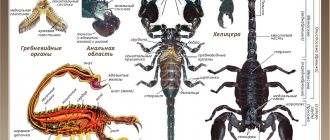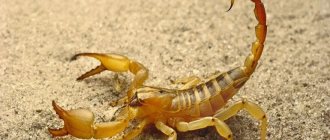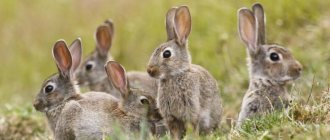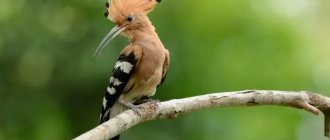- Wild animals
- >>
- Mammals
The Siberian roe deer is a fragile, small fallow deer. It has many names. The most common is eastern. The roe deer is considered the largest in the category of the smallest deer. Nature has endowed this animal with incredible grace, fragility and caution. Habits and lifestyle have a lot in common with goats. The European roe deer is considered its closest relative.
Origin of the species and description
Photo: Siberian roe deer
The Siberian roe deer is a herbivore, artiodactyl mammal. Belongs to the deer family, the roe deer genus. The ancient ancestors of the genus are the Miocene Munjacs. Scientists note that in the Upper Miocene and Lower Pliocene, throughout Europe and Asia, a group of animals lived that had many common characteristics with modern roe deer. Until recently, Siberian roe deer lived throughout the temperate climate.
Hunting from ambush
Winter roe deer walk along their favorite paths. If it is not possible to hunt from a tower, then you can build a forest blind and from there wait for the approach of the forest beauty. The ambush is made near the roe deer's bed or its feeding area. Hunting can take place in severe frost, so you should warm yourself.
The shelter is made from available materials: branches, boards, poles, spruce or pine spruce branches. It should not stand out among the forest. A perch on a tree is a storage shed from which you can also successfully track a roe deer. Clothes should not smell of cigarettes, alcohol or perfume, otherwise the animal will smell the hunter from a long distance and will not approach the shelter.
Roe deer on salt licks
Appearance and features
Photo: Female Siberian roe deer
The body length of this representative of the deer family does not exceed one and a half meters. Body height at the withers is 80-95 centimeters. The body weight of an adult is 30–45 kilograms. Males are slightly larger than females, but this is not pronounced.
Roe deer have a small, somewhat elongated muzzle. The size of the skull does not exceed 20-22 centimeters. There are high horns on the head, the length of which in some cases reaches half a meter. The horns are most often wide and spreading. Only males have long beautiful horns. Females do not have them at all, or have small, unattractive horns.
Video: Siberian roe deer
The coat in winter is thick with a reddish tint. In spring and summer, the gray color of the hairline predominates, while the white mirror in the tail area becomes the same color as the entire body. The fur sheds twice a year. In summer, the coat is significantly thinner and shorter. Females and males have the same coloration.
There are oblong, rounded ears on the head. The roe deer is distinguished by its huge black eyes with slanted pupils. The animal has a long, graceful neck without a mane. In males it is stronger and stockier than in females. Siberian roe deer have long, slender limbs. The forelimbs are somewhat shorter than the hind limbs. Because of this, the spine is slightly tilted forward. There is a small round tail that is surrounded by a ring of white fur called the speculum.
In the spring-summer period, males have very developed secretory glands, in particular, sebaceous and sweat glands. With their help, males leave marks indicating that they belong to a certain territory. Siberian roe deer have excellent, highly developed hearing and sense of smell.
Hunting from the approach
Roe deer are hunted in all seasons in a variety of ways. But approach fishing is possible only with the help of the most experienced hunter, because this is a difficult matter. To get a trophy, you need to go into the forest, not make noise there and behave as quietly as possible. Sometimes they take a husky or a friend. To ensure a successful hunt, you must first select a hunting location.
This is done in the off-season, studying the tracks of animals, exploring their paths. The hunter determines where the roe deer rested and where it quenched its thirst. Such reconnaissance can only be done by an experienced hunter who is well versed in the habits of roe deer and can distinguish their tracks.
Usually, in forest clearings and on the banks of rivers, several points for potential hunting are found at once. Depending on the weather, the hunter then chooses where it is best to go with a gun on his back. When hunting, be sure to take into account the strength and direction of the wind.
They go into the forest with an average wind blowing from the forest to the hunter. The hunter must dress appropriately. The suit should be comfortable, waterproof, not rustling, made of soft fabric, khaki or gray camouflage. In summer you should wear high rubber boots; in winter, EVA boots or felt boots with galoshes are preferable.
They go to the hunting site at night and arrive at dawn. At this time, you can shoot a grazing animal, but if you approach during the day, the roe deer will already be lying somewhere and it will be difficult to find it. In addition, the morning roe deer, busy eating grass or bark, is less careful than during the day.
Roe deer in the pasture in the morning
If you didn’t have time to approach it in the morning, then during the day you should look for the animal’s resting place by following its tracks. In winter, roe deer can be found feeding even during the day. In cold weather, a lot of food is needed, and in the morning hours it simply does not have time to get enough of the meager food, since most of the time was spent by the animal searching for food, and not eating.
If it is rainy outside, then you will be able to get as close as possible to the roe deer. Due to bad weather and wind, she stops hearing sounds and her sense of smell also becomes weakened, to the joy of her pursuer. Moving through the forest is always done against the wind. You cannot smoke, drink alcohol, or make phone calls in the forest.
The roe deer will hear and smell about this and will simply run away. When you spot a forest beauty, you should hide behind a tree, approaching it as silently as possible. The roe deer sees very poorly and therefore let the animal look at you, the main thing is that it does not smell the human smell.
When a hunter is detected, the roe deer begins to bark like a dog and then quickly runs away in the direction opposite to the person. They run away from the hunter at a speed of over fifty kilometers per hour. They achieve this through huge jumps, up to seven to eight meters long.
This is why a hunter should not allow himself to be identified before shooting. It is unlikely that you will be able to get close, so it is recommended to take a rifled gun for approach hunting. Usually only the most experienced hunters can get within fifty meters of a roe deer. So they can shoot an animal with a smooth-bore weapon.
Where does the Siberian roe deer live?
Photo: Siberian roe deer Red Book
The habitat is quite wide.
Habitat area of the Siberian roe deer:
- Northern regions of Mongolia;
- Western Territory of China;
- Middle Asia;
- Yakutia;
- Transbaikalia;
- Siberia;
- Ural.
In the old days, the ancestors of this species of artiodactyls chose forest-steppe territory for their habitat. However, with the expansion of the borders of human-developed territories, they moved into the forests. Roe deer choose as their habitat areas where they can easily hide and find food easily. If there are no problems with food, but there is difficulty with shelter, the animal will not stay here. This is explained by the development of the instinct of self-preservation.
Roe deer, living in open areas unprotected by dense vegetation, are easy prey for predators.
They prefer the foothills of mountain peaks, rocky terrain, tall bushes, and the shores of steppe reservoirs. In addition, these fragile animals love meadows and tall, thick grass. You can often find Siberian roe deer in swampy areas, coniferous and deciduous forests, and on agricultural land. They have excellent ability to adapt to cultivated areas. It should be noted that these seemingly gentle animals tolerate cold and persistent frosts very well.
The choice of settlement location is influenced by several main factors: the availability of a food source, shelter and the depth of the snow cover. The maximum permissible height of the snow layer is 0.5 meters. If the height exceeds this mark, the artiodactyls look for another place where the snow cover is significantly less. Another important condition is that there is no snow on the ground for most of the year.
Roe deer habitat
The main habitat of the roe deer is in Europe. The habitat ranges from the middle of Scandinavia to the Gulf of Finland. This animal can also be found in the countries of Asia Minor, Iran, Iraq, the Caucasus, and the Crimean Peninsula. The boundaries of the habitat also pass through Kazakhstan, Mongolia, Korea, Tibet and some other countries.
Most often, forest-steppe is chosen for living, especially places that are located near river valleys. Also, they can live in both coniferous (but in the presence of deciduous undergrowth) and deciduous forests. Some species also thrive in the Central Asian mountains. In those zones where the steppe is located, there is no semi-desert or desert.
They prefer to lead a sedentary lifestyle all year round. Individuals gather in small groups and are located in a certain territory. Even during particularly cold periods, the herd does not occupy an area larger than 2 hectares. In autumn and spring, they migrate over distances of up to 20 km.
In autumn, they prefer to go to areas where there is less snow and there is more food. With spring warming, they move to summer pastures. In the hot summer, they go to graze in the cool part of the day, and when the heat is at its peak, they lie in the grass or bushes.
In summer, each individual stays slightly apart from the others, defending its own territory. When the mating season ends, they unite into heterogeneous herds, the number of which can vary from 30 to 100 individuals. This group lives on an area of about 1000 hectares.
On average, the number of individuals per certain area increases in the direction from north to south: in the taiga zone there is 1 individual per 1000 hectares, in mixed and deciduous forests from 30 to 60, in the forest-steppe - from 50 to 120 animals.
What does the Siberian roe deer eat?
Photo: Male Siberian roe deer
Siberian roe deer are herbivores. However, it cannot be said that they feed only on grass. Animals can eat mushrooms, berries, young shoots, and leaves. In early spring, they eat the budding buds on trees. They prefer juicy, fresh greens. They can feed on dry vegetation and cereals when there is a lack of food.
In order for the body to receive the necessary minerals, roe deer eat salt licks or look for water sources that are enriched with minerals for watering. During the period of bearing and feeding cubs, the need for minerals increases several times.
The most difficult period for the Siberian roe deer is the end of winter. It is at this time that they feel an acute lack of mineral-rich food, as well as fluid. When bodies of water freeze, they can eat snow to replenish the body's fluid needs. In winter, in the absence of food, they can eat coniferous trees.
The digestive system of artiodactyls has a small stomach. Because of this, roe deer eat little. However, an active metabolism requires frequent food intake. During the day, one adult individual has at least 7-10 meals. The daily food intake for one individual is determined by its body weight and is approximately 2-2.5 kilograms of green vegetation. During the cold season, the daily amount of food decreases, as does its calorie content.
In conditions of food shortages, fierce competition grows between other representatives of ungulates and Siberian roe deer. In winter, in the absence of a food source, roe deer dig up snow with their hooves, digging out dry vegetation. They are able to get their food from under layers of snow, the thickness of which reaches half a meter.
Roe deer in the USSR
In Soviet times, the symbol of postal services was the roe deer. Pictures of the animal were found on postcards and stamps of the former USSR. New Year's, greeting, birthday and other holiday cards were very popular, in particular with the character of a roe deer as a symbol. So, in 1978, the artist Isakov depicted a whole series of paintings with roe deer, the idea was transferred to postcards. Postcards from this artist from 1978-1989 have survived to this day.
You can see what a roe deer looks like in photographs, stamps and postcards.
The postcards were both black and white and color. The roe deer was painted for the post office not only in the USSR; this character was no less welcomed by other countries.
Features of character and lifestyle
Photo: Siberian roe deer
These animals exhibit a cyclical pattern of daily activities. They alternate periods of grazing and movement with chewing food and resting and sleeping. Animals are most active and mobile in the early morning. Animals spend most of their time lying down. The beds are platforms that they clear of snow and dry vegetation with their hooves. Typically, Siberian roe deer choose places for bedding on the outskirts of clearings, or in forests.
By nature, Siberian roe deer are not solitary animals. They gather in small groups of 7-12 individuals. The group consists of a male, several females and young animals. In the cold season, small groups can unite into a herd, forming up to three dozen animals. With the onset of spring they disintegrate again.
Daily activity depends on several factors: seasonality, the number of individuals in the flock, the severity of anthropogenic pressure. In winter, the highest activity is observed in the early morning, in summer - at night and in the evening. With pronounced anthropogenic pressure, the greatest activity of individuals also occurs in the dark.
Siberian roe deer are tied to a specific habitat. Having mastered a certain territory, they tend to return there again and again. Males cover a certain territory, which they mark by rubbing their forehead and neck against trees. They can also dig the ground with their hooves, leaving a secretion between the toe glands. One adult male occupies a territory of 20 to 150 hectares. As a rule, the possessions of males do not overlap. Layering of sections on top of each other is possible only at high density.
It is unusual for males to enter other people's territories. With the onset of each new season, adult males win back their right to own territory.
Siberian roe deer are considered peace-loving, non-conflict animals. Even between males, conflicts rarely arise. When a controversial situation arises, they tend to demonstrate strength in front of their opponent. Roe deer make many different sounds.
Typical sound signals of Siberian roe deer:
- Whistling. It is typical when a female communicates with her cubs. It is a manifestation of restlessness and anxiety.
- Hissing, snorting. Expresses aggression and irritation.
- Barking. Can be emitted by disturbed, frightened individuals.
- Moan. Sounds from an animal that is trapped.
- Noisy jumping, clattering hooves. It is a characteristic sign of a feeling of danger, fear.
In the communication of individuals with each other, nonverbal language of postures plays an important role. Thus, they give each other alarm signals, calls to escape, etc. Roe deer tend to run fast and jump high. In an attempt to escape from being chased, Siberian roe deer jump more than five meters in height.
How to find a roe deer
Recently, hunting roe deer has become more difficult due to a decrease in the population and the high cost of a license. This makes it difficult to gain experience in the fishery. Complicating the situation is the fact that roe deer are very difficult to find. The search will make it easier to know the animal's habits.
A couple of weeks after the opening of the hunting season, roe deer are easier to find in small shelters than in forested areas. To mine them, it is better to choose the beginning of the week: Monday or Tuesday. The fact is that on weekends, hunters drive the animals hard and they huddle in shelters, from where only a dog can drive them out.
By nine to ten o'clock in the morning, the roe deer go to bed for the day. This is the optimal time to start fishing.
When searching for an object, you need to take into account that the animal perceives places such as ditches, forest edges as the banks of a river and moves along them for a long time, provided that it is not scared. No matter how reliable the shelter, sensing danger, the roe deer always turns out of it in the same place for many years. This happens until the surrounding area changes. You should look for such places at any time of the year, and set up ambushes there during the hunting season. The help of a dog will be very useful in roe deer hunting.
Social structure and reproduction
Photo: Siberian roe deer calf
The mating season for animals begins in mid-July and lasts one and a half to two months. Males are constantly looking for females; they eat practically nothing during this period. Females who have reached the age of two are considered sexually mature. If there are several contenders for the right to enter into mating relations with females, males may fight with each other.
There is also a manifestation of aggressiveness of males towards females. In one mating season, a male is able to fertilize up to 5-7 females. Female roe deer are also not distinguished by the formation of established connections. Although sometimes they can mate for several years in a row with the male they like best.
Latent pregnancy is observed in Siberian artiodactyls. That is, the resulting embryo stops growth and development for up to 3-4 months. If mating occurs in the fall, there is no latent period of pregnancy. As the embryo begins to grow, the female becomes more careful and careful. She is not characterized by sharp, dangerous jumps or too fast running. The gestation period is milked from 250 to 320 days. From one to three babies are born.
Roe deer cubs are very vulnerable and helpless. The female hides them in reliable shelters for several months.
The spots on the back help camouflage in thickets of vegetation. The mother is not far away, but prefers to feed and rest not with the babies, so as not to attract attention to them. The female maintains contact with the offspring until the emergence of a new generation.
Siberian roe deer have high fertility. With the onset of each new season, more than 96% of sexually mature female individuals of the species give birth. Despite high fertility, natural growth does not increase at a rapid pace. Among this species of ungulates, there is a low survival rate of cubs.
Hunting from the tower
Many hunting grounds have the opportunity to feed wild forest animals, including roe deer. They allow organized hunts for money from the towers. The tower has a loophole for shooting and is well camouflaged with boards and poles. It is made from scrap materials and is located several meters above the ground.
They climb it using a special ladder. Usually the feeding area for animals is located close to the tower. The man waits, and when the animals come up to feed, a shot is fired, which is most often successful. Animals get used to feeding and always come to their favorite place. Therefore, on such a simple hunt, a trophy is always guaranteed.
Some towers are not built near the bait area, but on the edge of the forest or forest meadow. The roe deer never looks up and therefore the hunter remains 100% invisible. If hunting is carried out at night, you can use a flashlight.
Night vision scopes are prohibited for use by legislation in some Russian regions. This kind of hunting is carried out by young people who are just learning the basics of hunting, and by older people who are already finding it difficult to run after a fleet-footed animal through windbreaks and forest ravines.
Natural enemies of Siberian roe deer
Photo: Siberian roe deer
The natural enemies of the Siberian roe deer are considered to be predatory animals. These include bears, lynxes, wolves, tigers. Foxes and predatory bird species pose a threat to young animals and helpless offspring.
Its small stature and natural gray-brown hair color allows it to blend in with the background of bushes, foliage and tall vegetation. Long legs allow you to run fast and overcome high obstacles. At the time of pursuit, adult roe deer reach speeds of up to 50 km/h. At this speed, they are not able to cover long distances. However, the ability to make similar jerks and jump up to 4-7 meters in height allows you to evade pursuit.
Another dangerous enemy of the Siberian roe deer is humans. It is thanks to the fact that people are actively destroying the natural habitat of these fragile animals, as well as hunting and poaching, that they are on the verge of extinction. The Siberian roe deer is a favorite trophy of hunters and poachers. Large, weighty antlers, skin and tender meat are always in demand and highly valued.
Popular message topics
- The workers of Kuban
Uban are a grain-producing land! A land of vineyards, orchards, corn, rice and many other winter crops. In this hot region, once upon a time, people had to make titanic efforts to keep the rivers from drying up. - Culture of Japan
Japan is an incredibly interesting and mysterious country. The culture of Japan is very original and diverse, which has been preserved for centuries and passed on from generation to generation. Culture is a mass of diverse traditions and customs. - Planet Uranus
Until now, our starry sky can open up new horizons and planets for us. Once upon a time, people lived without even thinking that somewhere far away, in space, there were many other planets. Each planet has its own characteristics and characteristics.
Population and species status
Photo: Female Siberian roe deer
There are some regions in whose Red Book it is listed. On the territory of the Russian Federation, the Siberian roe deer is listed in the Red Book of the Tomsk Region and Krasnoyarsk Territory. They have been given the status of a declining population.
In general, today the species is not in danger of extinction. Thanks to captive breeding in large numbers, there are about 10-13 million individuals in the center of Europe. Although just two or two and a half decades ago their numbers were more than half as large.
High fertility allows populations to quickly recover. In some regions, hunting for Siberian roe deer is even allowed after purchasing a license. In Central Asian countries, roe deer meat is considered a great delicacy due to its nutritional value.
Roe deer hunting
Roe deer is classified as a hunting species in the southern regions due to its high reproducibility. Also, roe deer meat is considered very healthy and nutritious. In many eastern countries, roe deer dishes are a common delicacy.
Those who do not hunt can buy roe deer meat. It is available for sale and on the Internet. For those who are interested in how to cook roe deer , there are many recipes for cooking roe deer that can be found on the Internet.
There are several types of roe deer hunting :
- with dogs
- surge
- trailing
- raid.
When hunting, roe deer decoy , of which there are two types. Some hunters hunt with a headlight by installing a special device called a headlight on their car.
Since roe deer are more active at night, roe deer are hunted at night. A roe deer hunting license is issued for shooting one individual per season and costs about 400 rubles.
A story about a roe deer
A report about roe deer for grade 4 will help you learn a lot of interesting things about this animal. The story about the roe deer can be supplemented with interesting facts.
Message about roe deer
Roe deer is one of the most beautiful and graceful animals. This is a small deer with a short body, slightly reminiscent of a goat. In summer, roe deer are golden-red in color, and in winter their color changes to gray. Roe deer have a blunt muzzle and a very short tail. There is light fur under the tail.
Where does the roe deer live?
Roe deer are widespread throughout the northern hemisphere; they can be found in North America, Europe, Asia Minor, and Russia. The roe deer lives in extremely diverse deciduous and mixed forests, avoiding only the dark coniferous taiga. It is found in shrub and reed thickets along the banks of steppe rivers and lakes, and rises along mountain slopes to subalpine and alpine meadows to an altitude of 3500 m above sea level
What does a roe deer eat?
Roe deer usually give birth to 1-2 cubs. They are always born spotted. On the 8th day they begin to follow their mother, but feed on mother’s milk for up to a month. Young roe deer often stay with their mother for a year, and sometimes longer, forming herds of 3–5, and occasionally more heads.
In winter, roe deer suffer from lack of food primarily due to their short stature, and stronger deer drive them away from feeders. Therefore, where there are a lot of deer, the number of roe deer decreases, and vice versa.
Enemies of the roe deer
The main enemy of the roe deer is the wolf. Wolves cause especially great damage to roe deer populations in winter, when snow cover is high. In Europe, including here in Crimea, roe deer, especially young ones, are often attacked by foxes. This predator, unable to kill an adult deer, copes with roe deer. Especially often, newborn roe deer and adult roe deer, exhausted at the end of winter, become victims of foxes.
The lifespan of roe deer is up to 15 years. The male sheds his antlers in December, and cleanses the new ones from remnants of skin in April–May.
Roe deer: interesting facts
They do not tolerate high snow cover well, and European roe deer already have difficulty moving on snow above 25-30 cm.
The famous Bambi, the hero of Felix Salten's works, was originally a roe deer.
Roe deer are the only species of deer that have a latent period of pregnancy; it is necessary so that babies cannot be born in winter, when lack of food and cold will doom them to rapid death. The pregnancy of a roe deer lasts from 5 to 10 months.
Roe deer swim well.
Roe deer can run away from predators at speeds of up to 60 km/h. But she can’t run for long at that speed.
Males can have a harem - they live with 2-3 females.
Source
